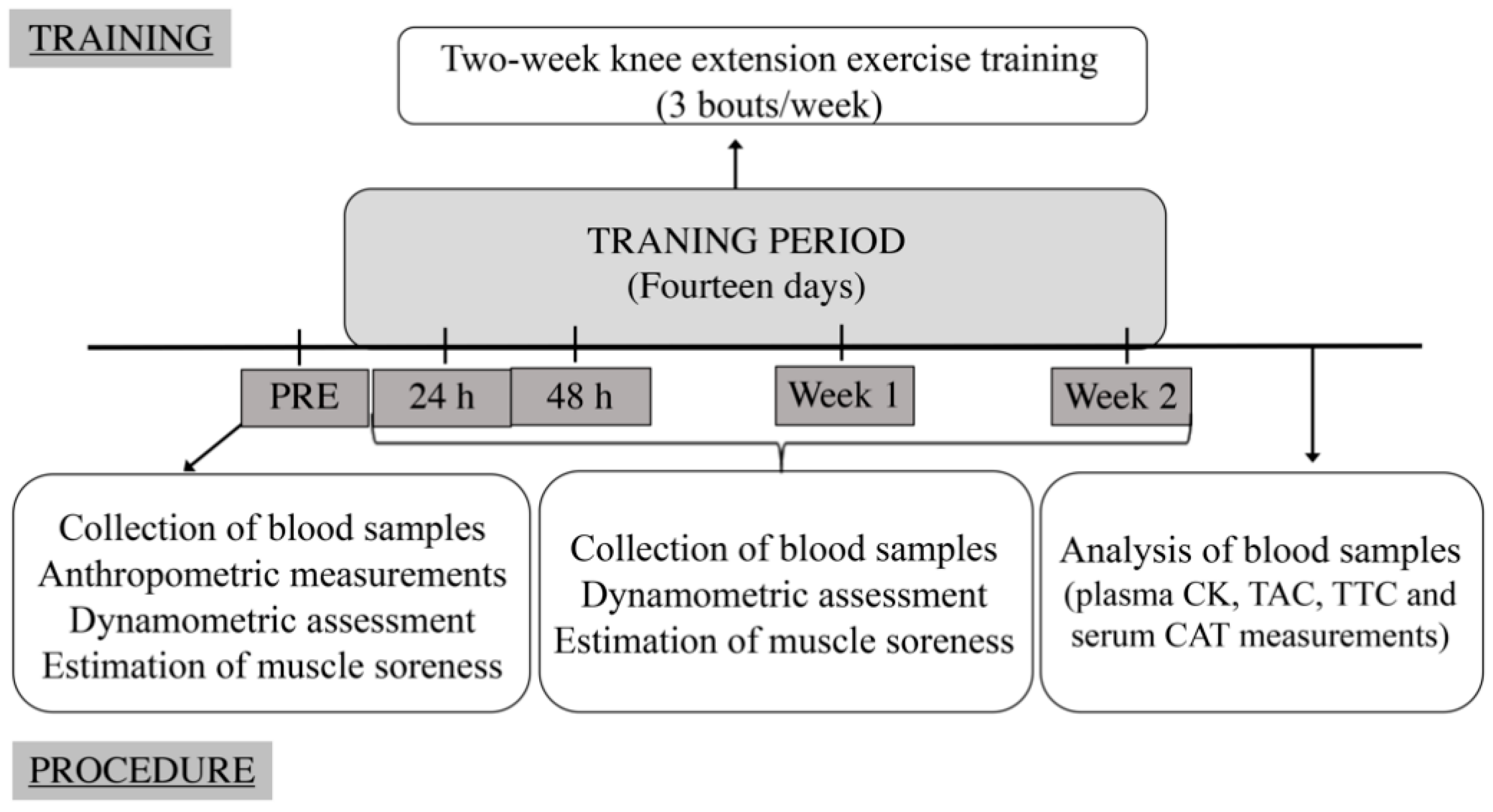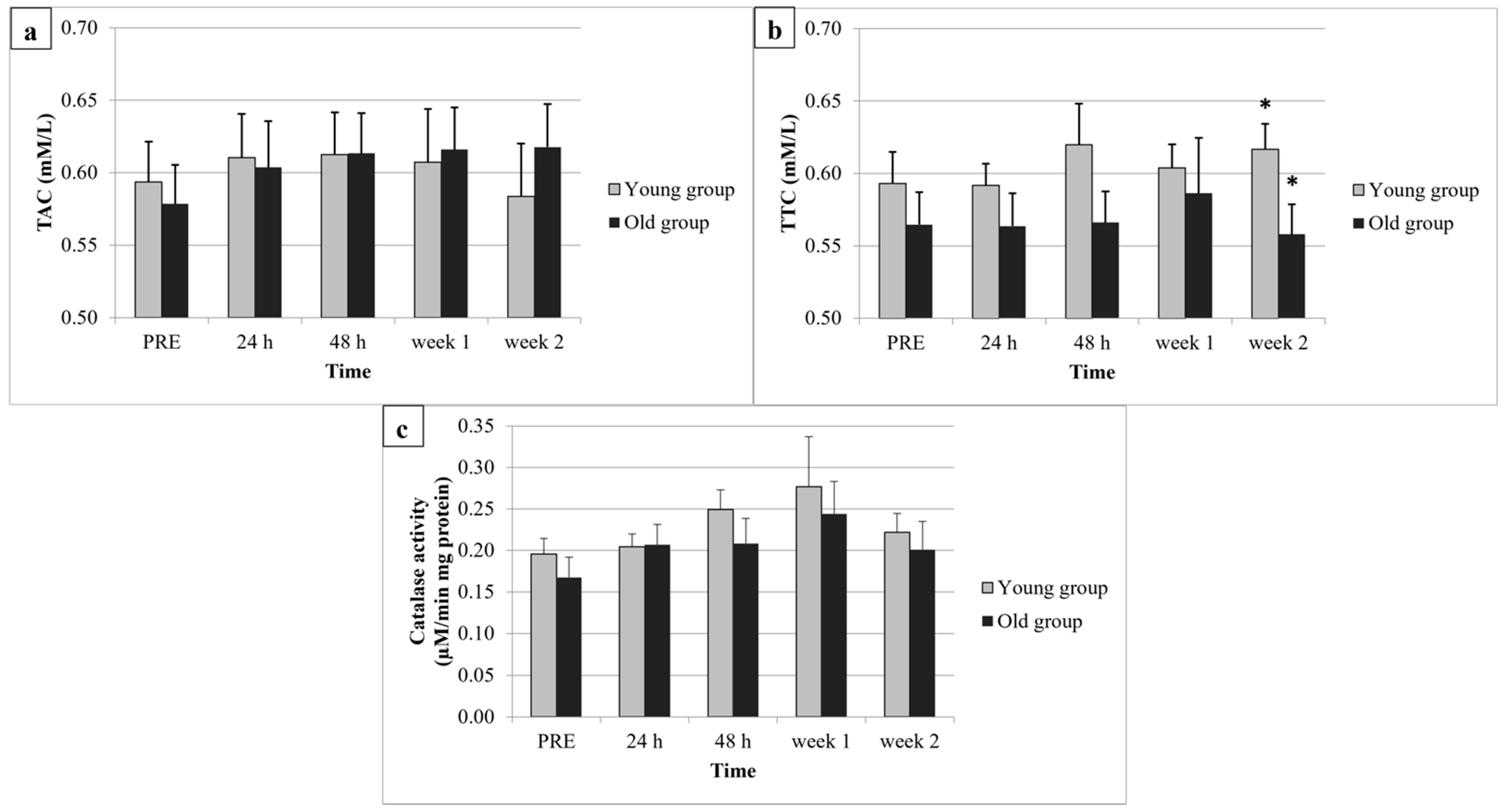Well-Trained Elders Have Antioxidant Responses and an Equal Magnitude of EIMD as Young Adults
Abstract
1. Introduction
2. Materials and Methods
2.1. Participants
2.2. Design and Procedures
2.3. Anthropometric Measurements
2.4. Quadriceps MVC Torque and Intensity of Muscle Soreness
2.5. Blood Sampling and Analyses
2.6. Dynamometric Exercise Training
2.7. Statistical Analyses
3. Results
4. Discussion
5. Conclusions
Author Contributions
Funding
Institutional Review Board Statement
Informed Consent Statement
Data Availability Statement
Acknowledgments
Conflicts of Interest
References
- Mora, J.C.; Valencia, W.M. Exercise and Older Adults. Clin. Geriatr. Med. 2018, 34, 145–162. [Google Scholar] [CrossRef]
- Billot, M.; Calvani, R.; Urtamo, A.; Sánchez-Sánchez, J.L.; Ciccolari-Micaldi, C.; Chang, M.; Roller-Wirnsberger, R.; Wirnsberger, G.; Sinclair, A.; Vaquero-Pinto, M.N.; et al. Preserving Mobility in Older Adults with Physical Frailty and Sarcopenia: Opportunities, Challenges, and Recommendations for Physical Activity Interventions. Clin. Interv. Aging 2020, 15, 1675–1690. [Google Scholar] [CrossRef]
- Sugimoto, T.; Arai, H.; Sakurai, T. An update on cognitive frailty: Its definition, impact, associated factors and underlying mechanisms, and interventions. Geriatr. Gerontol. Int. 2021, 22, 99–109. [Google Scholar] [CrossRef]
- Roig, M.; O’Brien, K.; Kirk, G.; Murray, R.; McKinnon, P.; Shadgan, B.; Reid, W.D. The effects of eccentric versus concentric resistance training on muscle strength and mass in healthy adults: A systematic review with meta-analysis. Br. J. Sports Med. 2008, 43, 556–568. [Google Scholar] [CrossRef]
- Gorianovas, G.; Skurvydas, A.; Streckis, V.; Brazaitis, M.; Kamandulis, S.; McHugh, M.P. Repeated Bout Effect Was More Expressed in Young Adult Males Than in Elderly Males and Boys. BioMed Res. Int. 2013, 2013, 218970. [Google Scholar] [CrossRef]
- Frontera, W.R.; Hughes, V.A.; Krivickas, L.S.; Kim, S.-K.; Foldvari, M.; Roubenoff, R. Strength training in older women: Early and late changes in whole muscle and single cells. Muscle Nerve 2003, 28, 601–608. [Google Scholar] [CrossRef]
- Hvid, L.; Suetta, C.; Nielsen, J.; Jensen, M.; Frandsen, U.; Ørtenblad, N.; Kjaer, M.; Aagaard, P. Aging impairs the recovery in mechanical muscle function following 4days of disuse. Exp. Gerontol. 2014, 52, 1–8. [Google Scholar] [CrossRef]
- Ferrari, G.S.L.; Ferrari, C.K.B. Exercise modulation of total antioxidant capacity (TAC): Towards a molecular signature of healthy aging. Front. Life Sci. 2011, 5, 81–90. [Google Scholar] [CrossRef]
- Ghiselli, A.; Serafini, M.; Natella, F.; Scaccini, C. Total antioxidant capacity as a tool to assess redox status: Critical view and experimental data. Free Radic. Biol. Med. 2000, 29, 1106–1114. [Google Scholar] [CrossRef]
- Afzalpour, M.; Gharakhanlou, R.; Gaeini, A.; Mohebbi, H.; Hedayati, M.; Khazaei, M. The effects of aerobic exercises on the serum oxidized LDL and total antioxidant capacity in non-active men. CVD Prev. Control 2008, 3, 77–82. [Google Scholar] [CrossRef]
- Birben, E.; Sahiner, U.M.; Sackesen, C.; Erzurum, S.; Kalayci, O. Oxidative stress and antioxidant defense. World Allergy Organ. J. 2012, 5, 9–19. [Google Scholar] [CrossRef]
- Paschalis, V.; Nikolaidis, M.G.; Fatouros, I.G.; Giakas, G.; Koutedakis, Y.; Karatzaferi, C.; Kouretas, D.; Jamurtas, A.Z. Uniform and prolonged changes in blood oxidative stress after muscle-damaging exercise. In Vivo 2007, 21, 877–884. [Google Scholar]
- Theodorou, A.A.; Nikolaidis, M.G.; Paschalis, V.; Sakellariou, G.K.; Fatouros, I.G.; Koutedakis, Y.; Jamurtas, A.Z. Comparison between Glucose-6-Phosphate Dehydrogenase-Deficient and Normal Individuals after Eccentric Exercise. Med. Sci. Sports Exerc. 2010, 42, 1113–1121. [Google Scholar] [CrossRef]
- McLeay, Y.; Stannard, S.; Houltham, S.; Starck, C. Dietary thiols in exercise: Oxidative stress defence, exercise performance, and adaptation. J. Int. Soc. Sports Nutr. 2017, 14, 12. [Google Scholar] [CrossRef]
- Gwoździński, K.; Pieniazek, A.; Brzeszczynska, J.; Tabaczar, S.; Jegier, A. Alterations in Red Blood Cells and Plasma Properties after Acute Single Bout of Exercise. Sci. World J. 2013, 2013, 168376. [Google Scholar] [CrossRef]
- Deminice, R.; Ribeiro, D.F.; Frajacomo, F.T.T. The Effects of Acute Exercise and Exercise Training on Plasma Homocysteine: A Meta-Analysis. PLoS ONE 2016, 11, e0151653. [Google Scholar] [CrossRef]
- Rossi, R.; Giustarini, D.; Milzani, A.; Dalle-Donne, I. Cysteinylation and homocysteinylation of plasma protein thiols during ageing of healthy human beings. J. Cell. Mol. Med. 2008, 13, 3131–3140. [Google Scholar] [CrossRef]
- Alikhani, S.; Sheikholeslami-Vatani, D. Oxidative stress and anti-oxidant responses to regular resistance training in young and older adult women. Geriatr. Gerontol. Int. 2019, 19, 419–422. [Google Scholar] [CrossRef]
- Nordin, T.C.; Done, A.J.; Traustadóttir, T. Acute exercise increases resistance to oxidative stress in young but not older adults. AGE 2014, 36, 9727. [Google Scholar] [CrossRef]
- Lewinska, A.; Wnuk, M.; Slota, E.; Bartosz, G. Total anti-oxidant capacity of cell culture media. Clin. Exp. Pharmacol. Physiol. 2007, 34, 781–786. [Google Scholar] [CrossRef]
- Lewinska, A.; Bartosz, G. A role for yeast glutaredoxin genes in selenite-mediated oxidative stress. Fungal Genet. Biol. 2008, 45, 1182–1187. [Google Scholar] [CrossRef] [PubMed]
- Jiménez-Jiménez, R.; Cuevas, M.J.; Almar, M.; Lima, E.; García-López, D.; De Paz, J.A.; González-Gallego, J. Eccentric training impairs NF-κB activation and over-expression of inflammation-related genes induced by acute eccentric exercise in the elderly. Mech. Ageing Dev. 2008, 129, 313–321. [Google Scholar] [CrossRef] [PubMed]
- Ploutz-Snyder, L.; Giamis, E.; Formikell, M.; Rosenbaum, A. Resistance training reduces susceptibility to eccentric exercise-induced muscle dysfunction in older women. J. Gerontol. Ser. A 2001, 56, B384–B390. [Google Scholar] [CrossRef] [PubMed]
- Chen, C.N.; Brown-Borg, H.M.; Rakoczy, S.G.; Thompson, L.D.V. Muscle disuse: Adaptation of antioxidant systems is age dependent. J. Gerontol. Ser. A 2008, 63, 461–466. [Google Scholar] [CrossRef][Green Version]
- Rao, D.V.; Boyle, G.M.; Parsons, P.G.; Watson, K.; Jones, G.L. Influence of ageing, heat shock treatment and in vivo total antioxidant status on gene-expression profile and protein synthesis in human peripheral lymphocytes. Mech. Ageing Dev. 2002, 124, 55–69. [Google Scholar]
- Carru, C.; Da Boit, M.; Paliogiannis, P.; Zinellu, A.; Sotgia, S.; Sibson, R.; Meakin, J.R.; Aspden, R.M.; Mangoni, A.A.; Gray, S.R. Markers of oxidative stress, skeletal muscle mass and function, and their responses to resistance exercise training in older adults. Exp. Gerontol. 2018, 103, 101–106. [Google Scholar] [CrossRef]
- Gomes, E.C.; Silva, A.N.; De Oliveira, M.R. Oxidants, Antioxidants, and the Beneficial Roles of Exercise-Induced Production of Reactive Species. Oxidative Med. Cell. Longev. 2012, 2012, 756132. [Google Scholar] [CrossRef]
- Theodorou, A.A.; Nikolaidis, M.G.; Paschalis, V.; Koutsias, S.; Panayiotou, G.; Fatouros, I.G.; Koutedakis, Y.; Jamurtas, A.Z. No effect of antioxidant supplementation on muscle performance and blood redox status adaptations to eccentric training. Am. J. Clin. Nutr. 2011, 93, 1373–1383. [Google Scholar] [CrossRef]
- Cui, H.; Kong, Y.; Zhang, H. Oxidative Stress, Mitochondrial Dysfunction, and Aging. J. Signal Transduct. 2012, 2012, 646354. [Google Scholar] [CrossRef]
- Traustadóttir, T.; Davies, S.S.; Su, Y.; Choi, L.; Brown-Borg, H.M.; Roberts, L.J., II; Harman, S.M. Oxidative stress in older adults: Effects of physical fitness. Age 2012, 34, 969–982. [Google Scholar] [CrossRef]


| Young Group | Old Group | |
|---|---|---|
| Decimal age (years) | 24.75 ± 0.88 | 63.67 ± 1.78 |
| Height (m) | 1.76 ± 0.03 | 1.76 ± 0.02 |
| Weight (kg) | 71.00 ± 2.28 * | 81.22 ± 3.05 * |
| BMI (kg/m2) | 23.00 ± 0.62 * | 26.21 ± 0.75 * |
| PRE | 24 h | |||||
|---|---|---|---|---|---|---|
| Young Group | Old Group | Total | Young Group | Old Group | Total | |
| MVC torque (Nm) | 249.56 ± 14.23 | 209.72 ± 14.53 | 228.47 ± 11.06 * | 219.13 ± 16.98 | 179.23 ± 13.38 | 198.00 ± 11.47 * |
| Plasma CK (U/L) | 163.14 ± 57.12 | 103.44 ± 13.92 | 129.56 ± 26.22 * | 549.14 ± 170.38 | 374.44 ± 96.05 | 456.76 ± 94.32 * |
| Intensity of muscle soreness | 0.00 ± 0.00 | 0.00 ± 0.00 | 0.00 ± 0.00 # | 24.00 ± 7.16.00 | 13.11 ± 3.10 | 18.24 ± 3.86 # |
Publisher’s Note: MDPI stays neutral with regard to jurisdictional claims in published maps and institutional affiliations. |
© 2022 by the authors. Licensee MDPI, Basel, Switzerland. This article is an open access article distributed under the terms and conditions of the Creative Commons Attribution (CC BY) license (https://creativecommons.org/licenses/by/4.0/).
Share and Cite
Tékus, E.; Szénási, N.L.; Szabó, E.; Heckel, Z.; Mintál, T.; Kőszegi, T.; Atlasz, T.; Gazdag, Z.; Váczi, M.; Wilhelm, M. Well-Trained Elders Have Antioxidant Responses and an Equal Magnitude of EIMD as Young Adults. Int. J. Environ. Res. Public Health 2022, 19, 8889. https://doi.org/10.3390/ijerph19158889
Tékus E, Szénási NL, Szabó E, Heckel Z, Mintál T, Kőszegi T, Atlasz T, Gazdag Z, Váczi M, Wilhelm M. Well-Trained Elders Have Antioxidant Responses and an Equal Magnitude of EIMD as Young Adults. International Journal of Environmental Research and Public Health. 2022; 19(15):8889. https://doi.org/10.3390/ijerph19158889
Chicago/Turabian StyleTékus, Eva, Nikolett Lilla Szénási, Edina Szabó, Zoltan Heckel, Tibor Mintál, Tamas Kőszegi, Tamas Atlasz, Zoltan Gazdag, Mark Váczi, and Marta Wilhelm. 2022. "Well-Trained Elders Have Antioxidant Responses and an Equal Magnitude of EIMD as Young Adults" International Journal of Environmental Research and Public Health 19, no. 15: 8889. https://doi.org/10.3390/ijerph19158889
APA StyleTékus, E., Szénási, N. L., Szabó, E., Heckel, Z., Mintál, T., Kőszegi, T., Atlasz, T., Gazdag, Z., Váczi, M., & Wilhelm, M. (2022). Well-Trained Elders Have Antioxidant Responses and an Equal Magnitude of EIMD as Young Adults. International Journal of Environmental Research and Public Health, 19(15), 8889. https://doi.org/10.3390/ijerph19158889







